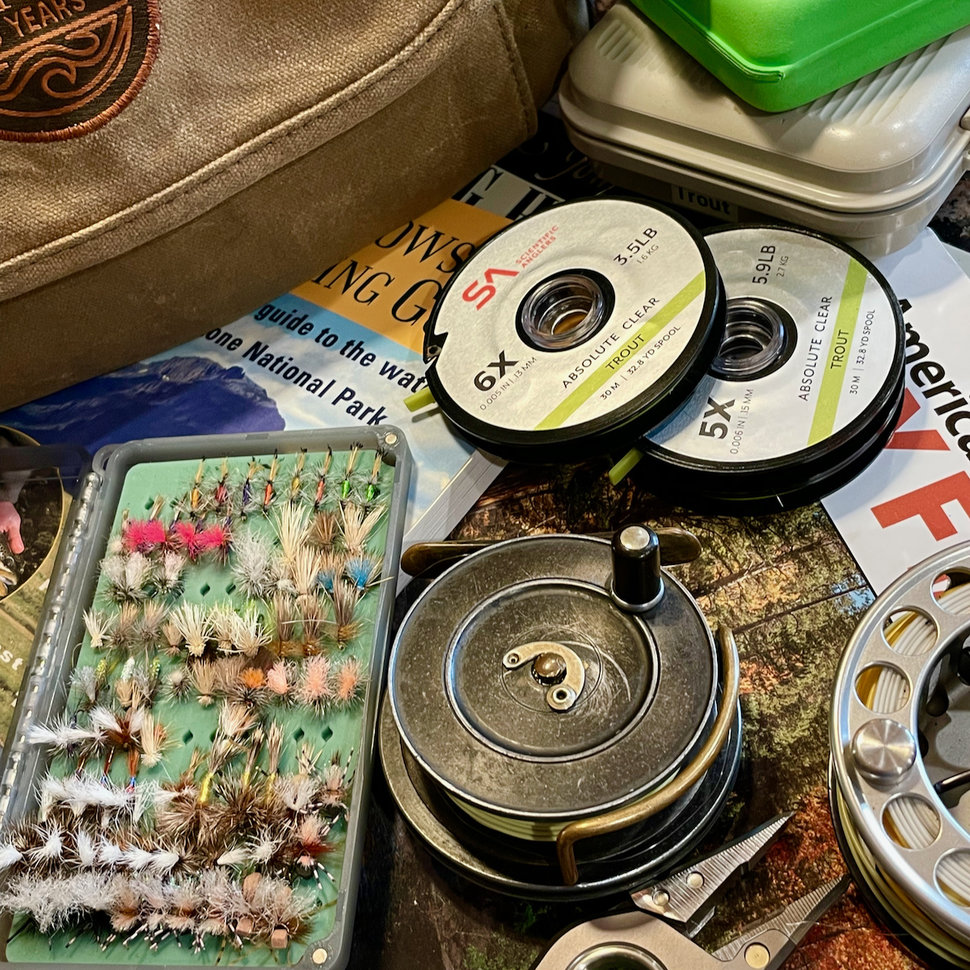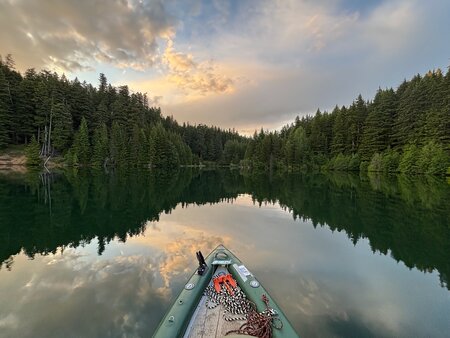Trout Preppers Top Ten List
12 Apr 2022

Spring blossoms signal the coming of Trout season, and while we are fortunate to have a year-round fishery on many of our favorite streams and lakes, nevertheless, there is a cause for celebration when the "opener" draws near. So, to prepare you for the festivities, I thought a brief to-do list would be helpful to avoid streamside disappointments. So, here are my Top Ten things to check BEFORE heading out to the river...
- Boots and waders: Clean your boots and inspect the laces, soles, and studs. Clean boots don't spread invasive species, and you don't want to be doing that. Replace worn laces as you know they will break the next time you use them. For you Boa lace users, pack a spare! This is an excellent time to check your waders for leaks. Gore-Tex waders need to be turned inside out and sprayed with rubbing alcohol. Pinholes will show up as dark spots. Simply dab a bit of Aquaseal on the spot and spread it with a gloved finger. If you have questions about this process, ask us! Do not attempt to repair seams if you suspect them to be the issue, as that will void your warranty. Instead, bring them to us, and we'll get it handled.
- Organize your fly boxes: pull out all those flies with bent hooks or tattered dressing. Put friends with friends, so you know where to look when you lose that hot fly in the tree. Having caddis/mayflies in one box or a part of one box cuts down on the hide and seek that shortens your fishing time. Check for rust or signs of bug infestation and remove anything that looks questionable. Oh, and make sure you have plenty of Salmonflies.
- Leader and tippet: anything bought last season (nylon/mono), especially 3x-7x, is questionable. Replace it. Mark the date on the new spool, and you will avoid disappointment when you finally raise that 20" to a sz.20. Fluorocarbon does not need to be replaced, but check how much remains on the spool. Running out is like a failure; it will cost you a fish.
- Fly floatant: how much is left in the tube, and where is your spare? Be sure to have floatant that works with CDC flies if you like to fish those. Fly driers like Dry Shake or an Amadou patch help keep your offerings on the surface once they've been sunk.
- Fly lines: are they clean? Clean lines cast and float better. Strip the line into warm soapy water and slosh it around to loosen dirt. Rinse well, then reel it through a dry cloth. Commercial line cleaners should be used sparingly. This is an excellent time to replace the leader and check the line at the loop for cracks and repair if needed with a bit of Aquaseal. Also, check your backing knot! Losing that fish of a lifetime because of knot failure will live with you forever. When in doubt, redo it. Check the backing for mildew and age. If it's looking a little funky, replace it.
- Fly reels: are they working like they did when they were new? Clean and lube your reels (if required) and ensure no dirt or rust affects their operation. Ensure the reel foot hasn't worked loose and that the spool is attached correctly to the frame with no rubbing from damage. Does the drag work smoothly or catch and slip? You still have time to get it checked and repaired, but don't put it off.
- Fly rods: cleaning last year's residue off the rods while checking for possible cracks or chips will help avoid a long ride home when your only rod breaks. While not all impacts to the rod will result in breakage, if the rod has been hit hard enough to show a crack in the finish, you may wish to carry a spare. Unfortunately, warranties don't kick in until complete failure has occurred, but having a spare keeps you on the water. Check for windings that are unraveling or guide coming loose. Your warranty does cover those, and getting them fixed now may avoid a less timely repair.
- Accessories: where are your pliers or that collection of strike indicators? Did you fix the bag on your net or replace the tip on your wading staff? Fix all that stuff you meant to last year. Make sure your tools are clean, sharp, and ready to use. Gather up all the trinkets you can't live without, then organize them in your vest or pack. Again, knowing where to look adds to your time on the water.
- Packs and vests: do you like your current system? Make sure your tackle is easy to get to and right where you want it. Clean out your vest/pack and get it organized. Remove anything you haven't used and lighten your load (remove those lovely rocks you picked up last summer.) Check zippers for corrosion. Lubricate zippers with silicone lube, check for tears or failure, and repair. Losing stuff on the trail is so newby.
- Hat and sunglasses: can you still see to tie on a fly in the fading light? Hats and glasses protect you from errant hooks while helping you see your target better, and adding a low-light polaroid sunglass could extend your angling hours. So could breaking down and getting a pair of cheaters to see those small hook eyes. Maybe it's time to update your prescription or your polaroid sunglasses. Adding a new lucky fishing lid to your collection will undoubtedly improve your chances of having a great season while cutting the glare off your glasses. Don't leave home without it!
So, there is it, my Trout Preppers Top Ten List. Is anything missing that you would add? Drop me a note and let me know!
Be the first to comment...




